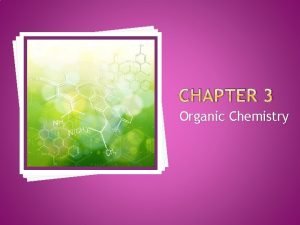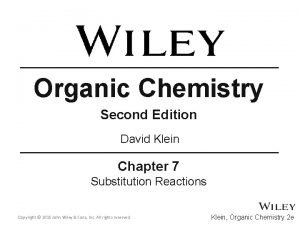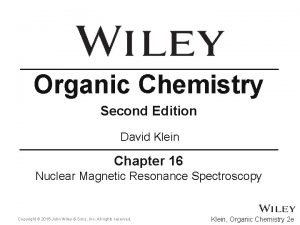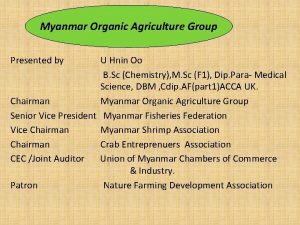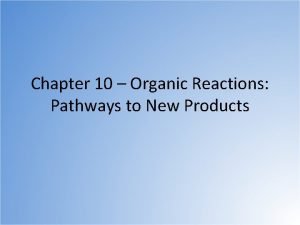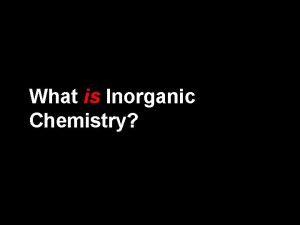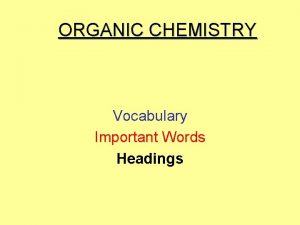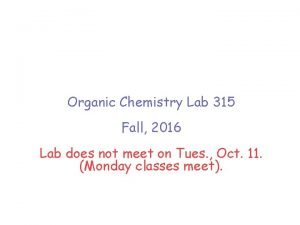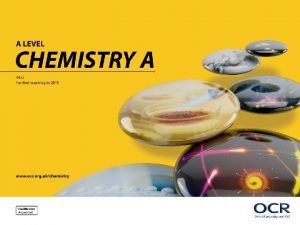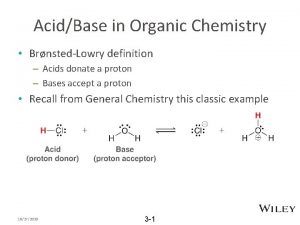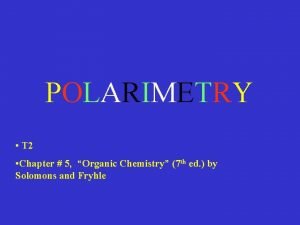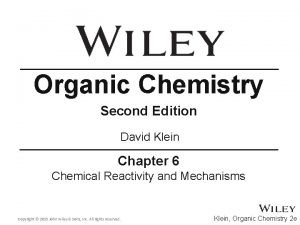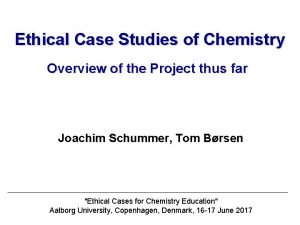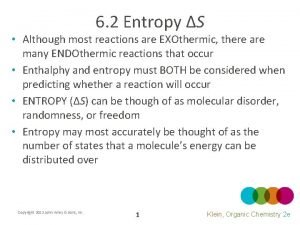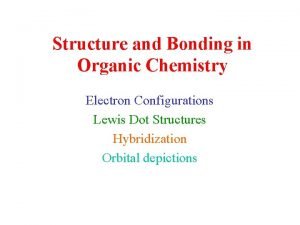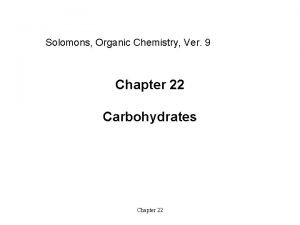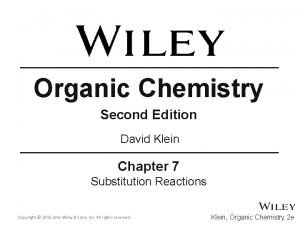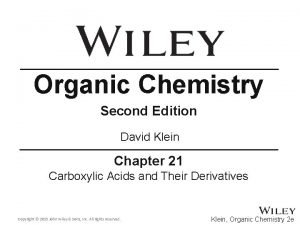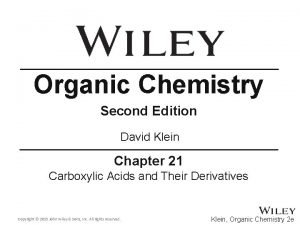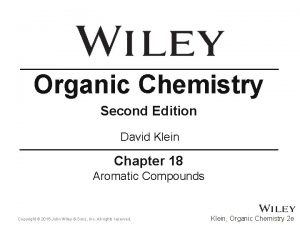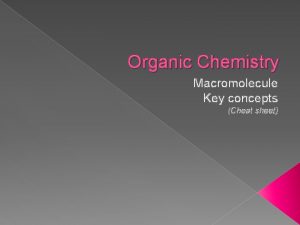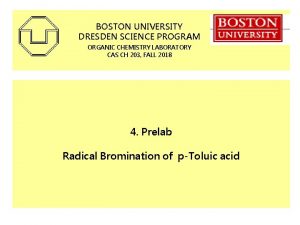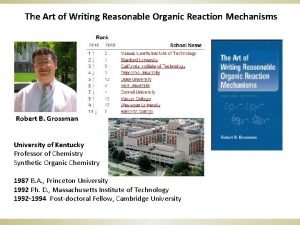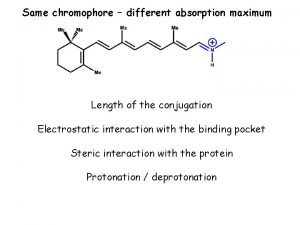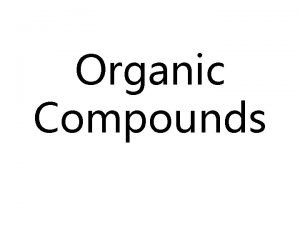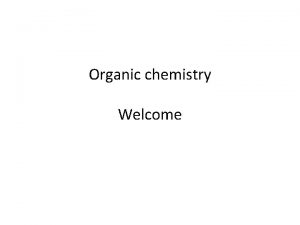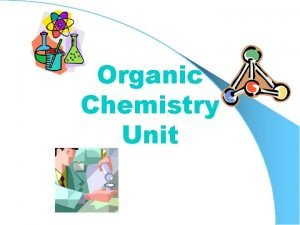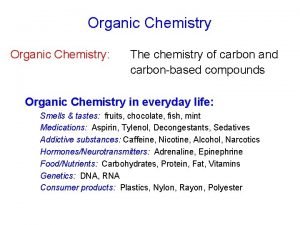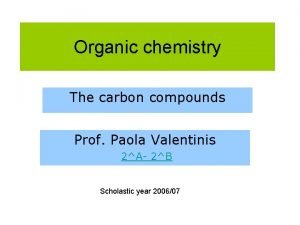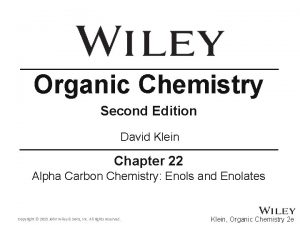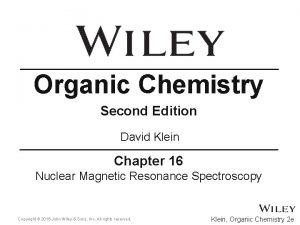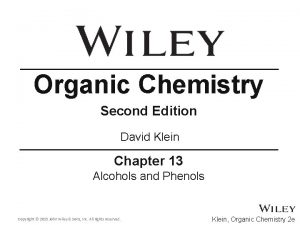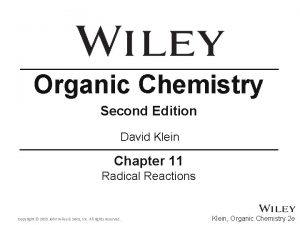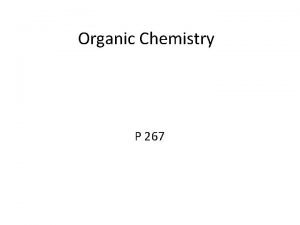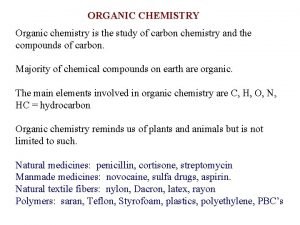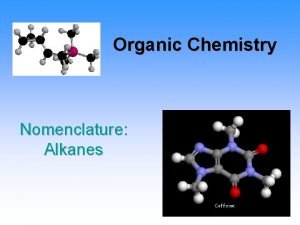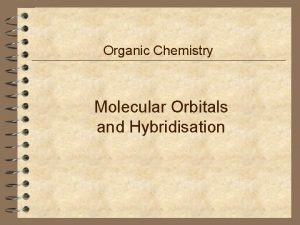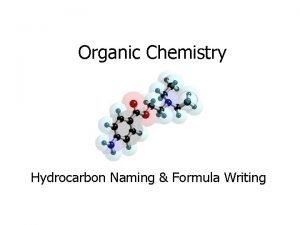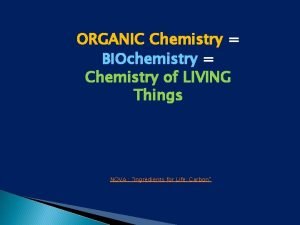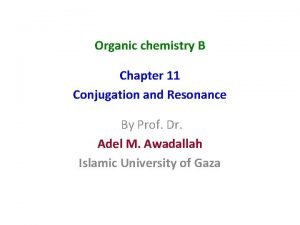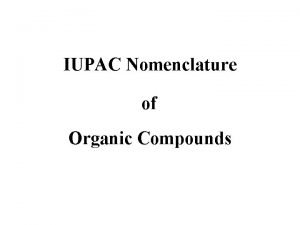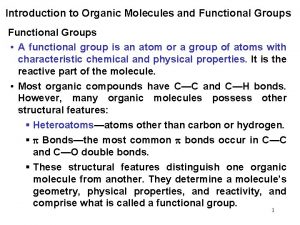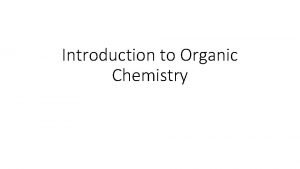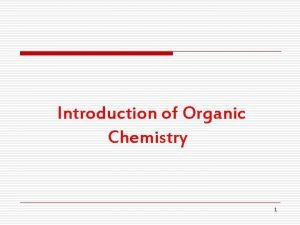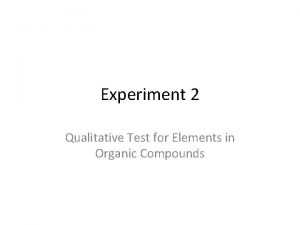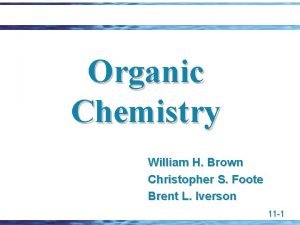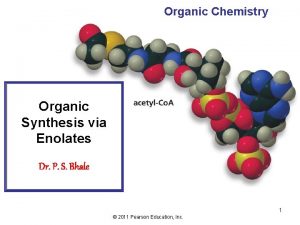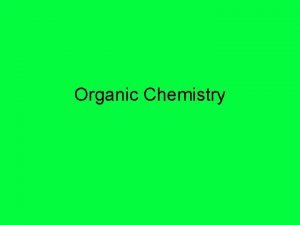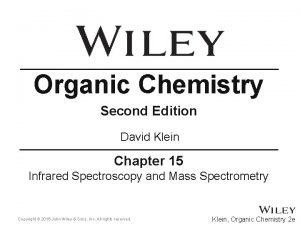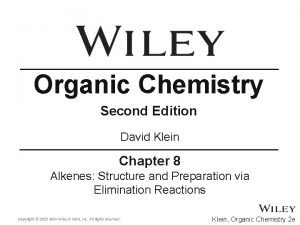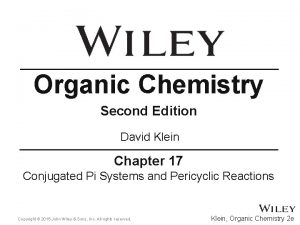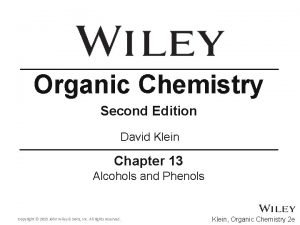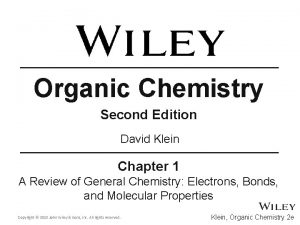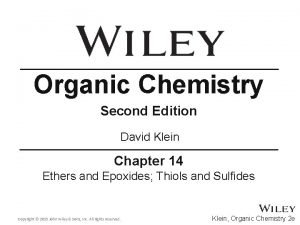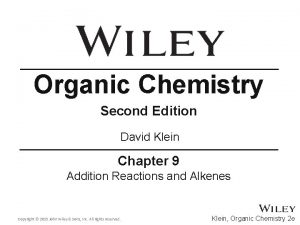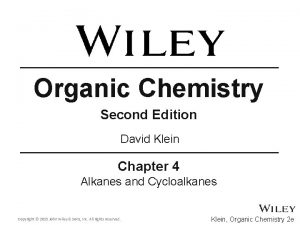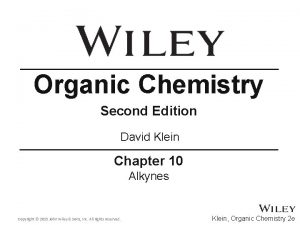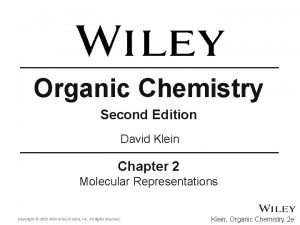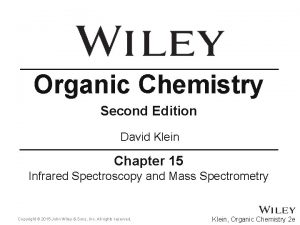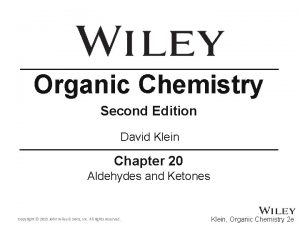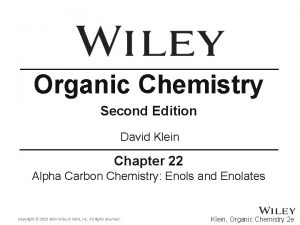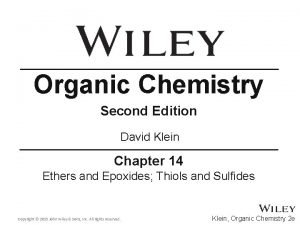Organic Chemistry Second Edition David Klein Chapter 17



































































![17. 9 Electrocyclic reactions • The disrotatory nature of the photochemical [2+2] electrocyclic ring-closing 17. 9 Electrocyclic reactions • The disrotatory nature of the photochemical [2+2] electrocyclic ring-closing](https://slidetodoc.com/presentation_image/1ef8f20bb6c4c53d34d4b41e3883cfc8/image-68.jpg)







![17. 10 Sigmatropic Rearrangements • The reaction below is a [1, 5] sigmatropic rearrangement 17. 10 Sigmatropic Rearrangements • The reaction below is a [1, 5] sigmatropic rearrangement](https://slidetodoc.com/presentation_image/1ef8f20bb6c4c53d34d4b41e3883cfc8/image-76.jpg)


![17. 10 Sigmatropic Rearrangements • The Cope rearrangement is a [3, 3] sigmatropic reaction 17. 10 Sigmatropic Rearrangements • The Cope rearrangement is a [3, 3] sigmatropic reaction](https://slidetodoc.com/presentation_image/1ef8f20bb6c4c53d34d4b41e3883cfc8/image-79.jpg)

![17. 10 Sigmatropic Rearrangements • The Claisen rearrangement is a [3, 3] sigmatropic reaction 17. 10 Sigmatropic Rearrangements • The Claisen rearrangement is a [3, 3] sigmatropic reaction](https://slidetodoc.com/presentation_image/1ef8f20bb6c4c53d34d4b41e3883cfc8/image-81.jpg)











- Slides: 92

Organic Chemistry Second Edition David Klein Chapter 17 Conjugated Pi Systems and Pericyclic Reactions Copyright © 2015 John Wiley & Sons, Inc. All rights reserved. Klein, Organic Chemistry 2 e

17. 1 Classes of Dienes • There are three categories for dienes • Cumulated – pi bonds are adjacent • Conjugated – pi bonds are separated by exactly ONE single bond • Isolated – pi bonds are separated by any distance greater than ONE single bond Copyright © 2015 John Wiley & Sons, Inc. All rights reserved. 17 -2 Klein, Organic Chemistry 2 e

17. 1 Classes of Dienes • There are three categories for dienes • Cumulated – pi bonds are perpendicular • Conjugated – pi bond overlap extends over the entire system • Isolated – pi bonds are separated by too great a distance to experience extra overlap Copyright © 2015 John Wiley & Sons, Inc. All rights reserved. 17 -3 Klein, Organic Chemistry 2 e

17. 1 Classes of Dienes • This chapter focuses on conjugated systems • Heteroatoms may be involved in a conjugated system • Draw a picture of the molecule shown to the right indicating where the pi bonds are and how they overlap • Practice with conceptual checkpoint 17. 1 Copyright © 2015 John Wiley & Sons, Inc. All rights reserved. 17 -4 Klein, Organic Chemistry 2 e

17. 2 Conjugated Dienes • A sterically hindered base can be used to form dienes while avoiding the competing substitution reaction • Practice with conceptual checkpoint 17. 2 Copyright © 2015 John Wiley & Sons, Inc. All rights reserved. 17 -5 Klein, Organic Chemistry 2 e

Copyright © 2015 John Wiley & Sons, Inc. All rights reserved. Klein, Organic Chemistry 2 e

17. 2 Conjugated Dienes • Single bonds that are part of a conjugated pi system are shorter than typical single bonds • What is a pm? • The hybridization of a carbon affects its bond length Copyright © 2015 John Wiley & Sons, Inc. All rights reserved. 17 -7 Klein, Organic Chemistry 2 e

17. 2 Conjugated Dienes • The more s-character a carbon has, the shorter its bonds will be. WHY? • Practice with conceptual checkpoint 17. 3 Copyright © 2015 John Wiley & Sons, Inc. All rights reserved. 17 -8 Klein, Organic Chemistry 2 e

17. 2 Conjugated Dienes • HOW do heats of hydrogenation provide information about stability? • WHY is energy released upon hydrogenation? Copyright © 2015 John Wiley & Sons, Inc. All rights reserved. 17 -9 Klein, Organic Chemistry 2 e

17. 2 Conjugated Dienes • HOW does conjugation affect stability? • Practice conceptual checkpoints 17. 4 and 17. 5 Copyright © 2015 John Wiley & Sons, Inc. All rights reserved. 17 -10 Klein, Organic Chemistry 2 e

17. 2 Conjugated Dienes • Rank the following compounds in order of increasing stability Copyright © 2015 John Wiley & Sons, Inc. All rights reserved. 17 -11 Klein, Organic Chemistry 2 e

17. 2 Conjugated Dienes • In general, single bonds will freely rotate • The two most stable rotational conformations for butadiene are the s-cis and s-trans • What does the “s” of s-cis and s-trans stand for? • Are there any other rotational conformations that you think might be possible? Copyright © 2015 John Wiley & Sons, Inc. All rights reserved. 17 -12 Klein, Organic Chemistry 2 e

17. 2 Conjugated Dienes • The s-cis and s-trans both allow for full pi system overlap • Other possible conformations will be higher in energy • WHY? Copyright © 2015 John Wiley & Sons, Inc. All rights reserved. 17 -13 Klein, Organic Chemistry 2 e

17. 2 Conjugated Dienes • Why is s-trans lower in energy? Copyright © 2015 John Wiley & Sons, Inc. All rights reserved. 17 -14 Klein, Organic Chemistry 2 e

17. 2 Conjugated Dienes • About 98% of the molecules are in the s-trans form Copyright © 2015 John Wiley & Sons, Inc. All rights reserved. 17 -15 Klein, Organic Chemistry 2 e

17. 2 Conjugated Dienes • The highest energy conformer will not be conjugated Copyright © 2015 John Wiley & Sons, Inc. All rights reserved. 17 -16 Klein, Organic Chemistry 2 e

17. 4 Electrophilic Addition • Recall the Markovnikov addition of H-X to a C=C double bond from section 9. 3 • With a conjugated diene as the substrate, two products are observed Copyright © 2015 John Wiley & Sons, Inc. All rights reserved. 17 -17 Klein, Organic Chemistry 2 e

17. 4 Electrophilic Addition • The pi electrons attack the acid to give the most stable carbocation • What intermediate would result if the H were added to any of the other carbons in the molecule? Copyright © 2015 John Wiley & Sons, Inc. All rights reserved. 17 -18 Klein, Organic Chemistry 2 e

17. 4 Electrophilic Addition • The resonance stabilized carbocation can be attacked by the halide at either site that is sharing the (+) charge • How is 1, 2 -addition different from 1, 4 -addition? • Practice with Skill. Builder 17. 1 Copyright © 2015 John Wiley & Sons, Inc. All rights reserved. 17 -19 Klein, Organic Chemistry 2 e

Copyright © 2015 John Wiley & Sons, Inc. All rights reserved. Klein, Organic Chemistry 2 e

Copyright © 2015 John Wiley & Sons, Inc. All rights reserved. Klein, Organic Chemistry 2 e

Copyright © 2015 John Wiley & Sons, Inc. All rights reserved. Klein, Organic Chemistry 2 e

17. 4 Electrophilic Addition • The addition of bromine to a diene also gives both 1, 2 and 1, 4 addition • Predict the MAJOR products for the reaction below. Pay close attention to stereochemistry Copyright © 2015 John Wiley & Sons, Inc. All rights reserved. 17 -23 Klein, Organic Chemistry 2 e

17. 5 Thermodynamic Control vs. Kinetic Control • The ratio of 1, 2 vs. 1, 4 addition is often temperature dependant • The energy diagram must be examined to see WHY temperature affects the product distribution Copyright © 2015 John Wiley & Sons, Inc. All rights reserved. 17 -24 Klein, Organic Chemistry 2 e

17. 5 Thermodynamic Control vs. Kinetic Control • Why are the products unequal in free energy? Copyright © 2015 John Wiley & Sons, Inc. All rights reserved. 17 -25 Klein, Organic Chemistry 2 e

17. 5 Thermodynamic Control vs. Kinetic Control • Predict the MAJOR product for the following reactions ° Copyright © 2015 John Wiley & Sons, Inc. All rights reserved. ° 17 -26 Klein, Organic Chemistry 2 e

Copyright © 2015 John Wiley & Sons, Inc. All rights reserved. Klein, Organic Chemistry 2 e

Copyright © 2015 John Wiley & Sons, Inc. All rights reserved. Klein, Organic Chemistry 2 e

17. 6 Intro to Pericyclic Reactions • Pericyclic reactions occur without ionic or free radical intermediates • There are three main types of pericyclic reactions 1. Cycloaddition reactions • How is it an addition reaction? Copyright © 2015 John Wiley & Sons, Inc. All rights reserved. 17 -29 Klein, Organic Chemistry 2 e

17. 6 Intro to Pericyclic Reactions • There are three main types of pericyclic reactions 2. Electrocyclic reactions 3. Sigmatropic rearrangements • What is the difference between an addition and a rearrangement? Copyright © 2015 John Wiley & Sons, Inc. All rights reserved. 17 -30 Klein, Organic Chemistry 2 e

17. 6 Intro to Pericyclic Reactions • Pericyclic reactions have 4 general features 1. The reaction mechanism is concerted. It proceeds without any intermediates 2. The mechanism involves a ring of electrons moving around a closed loop 3. The transition state is cyclic 4. The polarity of the solvent generally has no effect on the reaction rate. WHY is that significant? Copyright © 2015 John Wiley & Sons, Inc. All rights reserved. 17 -31 Klein, Organic Chemistry 2 e

17. 6 Intro to Pericyclic Reactions • Changes in the number of pi and sigma bonds distinguish the pericyclic reactions from one another Copyright © 2015 John Wiley & Sons, Inc. All rights reserved. 17 -32 Klein, Organic Chemistry 2 e

17. 7 Diels-Alder Reactions • Diels-Alder reactions can be very useful • They allow a synthetic chemist to quickly build molecular complexity • What is meant by [4+2] cycloaddition? • Like all pericyclic reactions, the mechanism is concerted Copyright © 2015 John Wiley & Sons, Inc. All rights reserved. 17 -33 Klein, Organic Chemistry 2 e

17. 7 Diels-Alder Reactions • The arrows could be drawn in a clockwise or counterclockwise direction • Can you draw a reasonable transition state? Copyright © 2015 John Wiley & Sons, Inc. All rights reserved. 17 -34 Klein, Organic Chemistry 2 e

17. 7 Diels-Alder Reactions • Why do the products generally have lower free energy? Copyright © 2015 John Wiley & Sons, Inc. All rights reserved. 17 -35 Klein, Organic Chemistry 2 e

17. 7 Diels-Alder Reactions • Most Diels-Alder reactions are thermodynamically favored at low and moderate temperatures • At temperatures above 200 C, the retro. Diels-Alder can predominate • Will the reaction probably be favored or disfavored by entropy? Copyright © 2015 John Wiley & Sons, Inc. All rights reserved. 17 -36 Klein, Organic Chemistry 2 e

17. 7 Diels-Alder Reactions • The pi sigma conversion provides a (-)ΔH Copyright © 2015 John Wiley & Sons, Inc. All rights reserved. 17 -37 Klein, Organic Chemistry 2 e

17. 7 Diels-Alder Reactions • ΔS should be (-) – Two molecules combine to form ONE – A ring (with limited rotational freedom) forms • What will the sign (+/-) be for the –TΔS term? Copyright © 2015 John Wiley & Sons, Inc. All rights reserved. 17 -38 Klein, Organic Chemistry 2 e

17. 7 Diels-Alder Reactions • Given the signs for ΔH and –TΔS, how should temperature affect reaction spontaneity (reactant vs. product favorability)? • Are there any disadvantages if the temperature is too low? Think kinetics Copyright © 2015 John Wiley & Sons, Inc. All rights reserved. 17 -39 Klein, Organic Chemistry 2 e

17. 7 Diels-Alder Reactions • In the Diels-Alder reaction, the reactants are generally classified as either the diene or dienophile • If a dienophile is not substituted with an electron withdrawing group, it will not be kinetically favored (a lot of activation energy or high temperature is required) • However, high temps do not favor the products thermodynamically Copyright © 2015 John Wiley & Sons, Inc. All rights reserved. 17 -40 Klein, Organic Chemistry 2 e

17. 7 Diels-Alder Reactions • When an electron withdrawing group is attached to the dienophile, the reaction is generally spontaneous • Show the groups highlighted in red are electron withdrawing using resonance and induction where appropriate Copyright © 2015 John Wiley & Sons, Inc. All rights reserved. 17 -41 Klein, Organic Chemistry 2 e

17. 7 Diels-Alder Reactions • Diels-Alder reactions are stereospecific depending on whether the (E) or (Z) dienophile is used • Which alkene is (E) and which is (Z)? • We will investigate the stereochemical outcome later in this chapter Copyright © 2015 John Wiley & Sons, Inc. All rights reserved. 17 -42 Klein, Organic Chemistry 2 e

17. 7 Diels-Alder Reactions • A CΞC triple bond can also act as a dienophile • Practice with Skill. Builder 17. 3 Copyright © 2015 John Wiley & Sons, Inc. All rights reserved. 17 -43 Klein, Organic Chemistry 2 e

Copyright © 2015 John Wiley & Sons, Inc. All rights reserved. Klein, Organic Chemistry 2 e

Copyright © 2015 John Wiley & Sons, Inc. All rights reserved. Klein, Organic Chemistry 2 e

17. 7 Diels-Alder Reactions • Predict products for the following reactions Copyright © 2015 John Wiley & Sons, Inc. All rights reserved. 17 -46 Klein, Organic Chemistry 2 e

17. 7 Diels-Alder Reactions • Diels-Alder reactions can also be affected by diene structure • Recall that many dienes can exist in an s-cis or an s-trans rotational conformation • Which conformation is generally more stable, and WHY? • Diels-Alder reactions can ONLY proceed when the diene adopts the s-cis conformation Copyright © 2015 John Wiley & Sons, Inc. All rights reserved. 17 -47 Klein, Organic Chemistry 2 e

17. 7 Diels-Alder Reactions • Dienes that can only exist in an s-trans conformation can not undergo Diels-Alder reactions, because carbons 1 and 4 are too far apart 4 1 • Dienes that are locked into the s-cis conformation undergo Diels-Alder reactions readily • Cyclopentadiene is so reactive, that at room temperature, two molecule will react together. Show the reaction and products Copyright © 2015 John Wiley & Sons, Inc. All rights reserved. 17 -48 Klein, Organic Chemistry 2 e

17. 7 Diels-Alder Reactions • Draw four potential bicyclic Diels-Alder products for the reaction below • Two of the potential stereoisomers are impossible. WHICH ones and WHY? Copyright © 2015 John Wiley & Sons, Inc. All rights reserved. 17 -49 Klein, Organic Chemistry 2 e

17. 7 Diels-Alder Reactions • When bicyclic systems form, the terms ENDO and EXO are used to describe functional group positioning Copyright © 2015 John Wiley & Sons, Inc. All rights reserved. 17 -50 Klein, Organic Chemistry 2 e

17. 7 Diels-Alder Reactions • The electron withdrawing groups attached to dieneophiles tend to occupy the ENDO position Major Product Copyright © 2015 John Wiley & Sons, Inc. All rights reserved. 17 -51 Minor Product Klein, Organic Chemistry 2 e

17. 7 Diels-Alder Reactions • The Diels-Alder transition state that produces the ENDO product benefits from favorable pi system interactions • Is this a kinetic or thermodynamic argument? • Draw an appropriate energy diagram • Practice with conceptual checkpoint 17. 19 Copyright © 2015 John Wiley & Sons, Inc. All rights reserved. 17 -52 Klein, Organic Chemistry 2 e

Copyright © 2015 John Wiley & Sons, Inc. All rights reserved. Klein, Organic Chemistry 2 e

Copyright © 2015 John Wiley & Sons, Inc. All rights reserved. Klein, Organic Chemistry 2 e

17. 9 Electrocyclic reactions • Determine how the number of σ and π bonds change for the representative electrocyclic reactions below • Explain why the equilibrium favor either products or reactants in the examples above Copyright © 2015 John Wiley & Sons, Inc. All rights reserved. 17 -55 Klein, Organic Chemistry 2 e

17. 9 Electrocyclic reactions • When substituents are present on the terminal carbons, stereoisomers are possible • Note that the use of light versus heat gives different products. See next few slides for explanation Copyright © 2015 John Wiley & Sons, Inc. All rights reserved. 17 -56 Klein, Organic Chemistry 2 e

17. 9 Electrocyclic reactions • Often the energy present at room temperature is sufficient to promote thermal electrocyclic reactions • Note that with the use heat, the configuration of the reactant determines the product formed Copyright © 2015 John Wiley & Sons, Inc. All rights reserved. 17 -57 Klein, Organic Chemistry 2 e

17. 9 Electrocyclic reactions Molecular orbitals of pi systems (ethylene): Copyright © 2015 John Wiley & Sons, Inc. All rights reserved. 17 -58 Klein, Organic Chemistry 2 e

17. 9 Electrocyclic reactions Molecular orbitals of pi systems (butadiene): Copyright © 2015 John Wiley & Sons, Inc. All rights reserved. 17 -59 Klein, Organic Chemistry 2 e

17. 9 Electrocyclic reactions • The symmetry of the HOMO determines the outcome • The terminal carbons rotate as they become sp 3 hybridized and overlap lobes that are in phase Copyright © 2015 John Wiley & Sons, Inc. All rights reserved. 17 -60 Klein, Organic Chemistry 2 e

17. 9 Electrocyclic reactions • The terminal carbons rotate as they become sp 3 hybridized and overlap lobes that are in phase • Disrotatory rotation (one rotates clockwise and the other counterclockwise) gives the cis product Copyright © 2015 John Wiley & Sons, Inc. All rights reserved. 17 -61 Klein, Organic Chemistry 2 e

17. 9 Electrocyclic reactions • Use MO theory to explain the products for the reactions below • Will disrotatory or conrotatory rotation be necessary? • Practice with conceptual checkpoint 17. 21 Copyright © 2015 John Wiley & Sons, Inc. All rights reserved. 17 -62 Klein, Organic Chemistry 2 e

Copyright © 2015 John Wiley & Sons, Inc. All rights reserved. Klein, Organic Chemistry 2 e

17. 9 Electrocyclic reactions • Predict the major product for the reaction below. Pay close attention to stereochemistry Copyright © 2015 John Wiley & Sons, Inc. All rights reserved. 17 -64 Klein, Organic Chemistry 2 e

17. 9 Electrocyclic reactions • Under photochemical conditions, light energy excites an electron from the HOMO to the LUMO • What was the LUMO becomes the new HOMO Copyright © 2015 John Wiley & Sons, Inc. All rights reserved. 17 -65 Klein, Organic Chemistry 2 e

17. 9 Electrocyclic reactions • Will the new excited HOMO react disrotatory or conrotatory? • Draw the expected product Copyright © 2015 John Wiley & Sons, Inc. All rights reserved. 17 -66 Klein, Organic Chemistry 2 e

17. 9 Electrocyclic reactions • Make the same MO analysis to predict the symmetryallowed product for the reaction below. Pay close attention to stereochemistry Copyright © 2015 John Wiley & Sons, Inc. All rights reserved. 17 -67 Klein, Organic Chemistry 2 e
![17 9 Electrocyclic reactions The disrotatory nature of the photochemical 22 electrocyclic ringclosing 17. 9 Electrocyclic reactions • The disrotatory nature of the photochemical [2+2] electrocyclic ring-closing](https://slidetodoc.com/presentation_image/1ef8f20bb6c4c53d34d4b41e3883cfc8/image-68.jpg)
17. 9 Electrocyclic reactions • The disrotatory nature of the photochemical [2+2] electrocyclic ring-closing is difficult to observe directly, because thermodynamically favors ring opening • The ring-opening reaction gives products that result from disrotatory rotation. Predict products below Copyright © 2015 John Wiley & Sons, Inc. All rights reserved. 17 -68 Klein, Organic Chemistry 2 e

17. 9 Electrocyclic reactions • The Woodward-Hoffmann rules for thermal and photochemical electrocyclic reactions are found in table 17. 2 • Practice with Skill. Builder 17. 4 Copyright © 2015 John Wiley & Sons, Inc. All rights reserved. 17 -69 Klein, Organic Chemistry 2 e

Copyright © 2015 John Wiley & Sons, Inc. All rights reserved. Klein, Organic Chemistry 2 e

Copyright © 2015 John Wiley & Sons, Inc. All rights reserved. Klein, Organic Chemistry 2 e

Copyright © 2015 John Wiley & Sons, Inc. All rights reserved. Klein, Organic Chemistry 2 e

Copyright © 2015 John Wiley & Sons, Inc. All rights reserved. Klein, Organic Chemistry 2 e

17. 10 Sigmatropic Rearrangements • Sigmatropic Rearrangements – a pericyclic reaction in which one sigma bond is replaced with another • Note that the pi bonds move their location Copyright © 2015 John Wiley & Sons, Inc. All rights reserved. 17 -74 Klein, Organic Chemistry 2 e

17. 10 Sigmatropic Rearrangements • The notation for sigmatropic rearrangements is different from reactions we have seen so far • Count the number of atoms on each side of the sigma bonds that are breaking and forming • This is a [3, 3] sigmatropic rearrangement Copyright © 2015 John Wiley & Sons, Inc. All rights reserved. 17 -75 Klein, Organic Chemistry 2 e
![17 10 Sigmatropic Rearrangements The reaction below is a 1 5 sigmatropic rearrangement 17. 10 Sigmatropic Rearrangements • The reaction below is a [1, 5] sigmatropic rearrangement](https://slidetodoc.com/presentation_image/1ef8f20bb6c4c53d34d4b41e3883cfc8/image-76.jpg)
17. 10 Sigmatropic Rearrangements • The reaction below is a [1, 5] sigmatropic rearrangement • Practice with conceptual checkpoint 17. 25 Copyright © 2015 John Wiley & Sons, Inc. All rights reserved. 17 -76 Klein, Organic Chemistry 2 e

Copyright © 2015 John Wiley & Sons, Inc. All rights reserved. Klein, Organic Chemistry 2 e

Copyright © 2015 John Wiley & Sons, Inc. All rights reserved. Klein, Organic Chemistry 2 e
![17 10 Sigmatropic Rearrangements The Cope rearrangement is a 3 3 sigmatropic reaction 17. 10 Sigmatropic Rearrangements • The Cope rearrangement is a [3, 3] sigmatropic reaction](https://slidetodoc.com/presentation_image/1ef8f20bb6c4c53d34d4b41e3883cfc8/image-79.jpg)
17. 10 Sigmatropic Rearrangements • The Cope rearrangement is a [3, 3] sigmatropic reaction in which all 6 atoms in the cyclic transition state are CARBONS • In general, what factors affect the spontaneity of the reaction (product favored vs. reactant favored)? • Practice with conceptual checkpoint 17. 26 Copyright © 2015 John Wiley & Sons, Inc. All rights reserved. 17 -79 Klein, Organic Chemistry 2 e

Copyright © 2015 John Wiley & Sons, Inc. All rights reserved. Klein, Organic Chemistry 2 e
![17 10 Sigmatropic Rearrangements The Claisen rearrangement is a 3 3 sigmatropic reaction 17. 10 Sigmatropic Rearrangements • The Claisen rearrangement is a [3, 3] sigmatropic reaction](https://slidetodoc.com/presentation_image/1ef8f20bb6c4c53d34d4b41e3883cfc8/image-81.jpg)
17. 10 Sigmatropic Rearrangements • The Claisen rearrangement is a [3, 3] sigmatropic reaction in which one of the 6 atoms in the cyclic transition state is an OXYGEN • In general, what factors affect the spontaneity of the reaction? • Practice with conceptual checkpoints 17. 27 and 17. 28 Copyright © 2015 John Wiley & Sons, Inc. All rights reserved. 17 -81 Klein, Organic Chemistry 2 e

Copyright © 2015 John Wiley & Sons, Inc. All rights reserved. Klein, Organic Chemistry 2 e

17. 10 Sigmatropic Rearrangements • Two pericyclic reactions occur in the biosynthesis of Vitamin D Copyright © 2015 John Wiley & Sons, Inc. All rights reserved. 17 -83 Klein, Organic Chemistry 2 e

17. 12 Color • The visible region of the spectrum (400 -700 nm) is lower energy than UV radiation • Lycopene is responsible for the red color of tomatoes • Β-carotene is responsible for the orange color of carrots Copyright © 2015 John Wiley & Sons, Inc. All rights reserved. 17 -84 Klein, Organic Chemistry 2 e

17. 12 Color • The color observed by your eyes will be the opposite of what is required to cause the π π* excitation. WHY? • Practice with conceptual checkpoint 17. 31 Copyright © 2015 John Wiley & Sons, Inc. All rights reserved. 17 -85 Klein, Organic Chemistry 2 e

Copyright © 2015 John Wiley & Sons, Inc. All rights reserved. Klein, Organic Chemistry 2 e

17. 12 Color • Bleaching agents generally work by breaking up conjugation through an addition reaction • Destroying long range conjugation destroys the ability to absorb colored light. WHY? • Does bleach actually remove stains? Copyright © 2015 John Wiley & Sons, Inc. All rights reserved. 17 -87 Klein, Organic Chemistry 2 e

Additional Practice Problems • Explain the relationship between heat of hydrogenation and stability of a pi system. Copyright © 2015 John Wiley & Sons, Inc. All rights reserved. 17 -88 Klein, Organic Chemistry 2 e

Additional Practice Problems • Explain why the instability of electrons in a pi MO directly relates to the number of nodes the orbital posses. Copyright © 2015 John Wiley & Sons, Inc. All rights reserved. 17 -89 Klein, Organic Chemistry 2 e

Additional Practice Problems • Give a complete mechanism and predict the major product for the addition reaction below. Copyright © 2015 John Wiley & Sons, Inc. All rights reserved. 17 -90 Klein, Organic Chemistry 2 e

Additional Practice Problems • Predict the products and give necessary conditions for the compound below to undergo a retro Diels-Alder Copyright © 2015 John Wiley & Sons, Inc. All rights reserved. 17 -91 Klein, Organic Chemistry 2 e

Additional Practice Problems • Predict the products for the electrocyclic ring-opening below with proper stereochemical configuration. Copyright © 2015 John Wiley & Sons, Inc. All rights reserved. 17 -92 Klein, Organic Chemistry 2 e
 Organic chemistry second edition david klein
Organic chemistry second edition david klein Rearranged most stable carbocation is
Rearranged most stable carbocation is Organic chemistry david klein 3rd edition
Organic chemistry david klein 3rd edition Organic chemistry david klein 3rd edition
Organic chemistry david klein 3rd edition Organic chemistry third edition david klein
Organic chemistry third edition david klein Is alkane an organic compound
Is alkane an organic compound Organic chemistry
Organic chemistry Organic chemistry (3rd) edition chapter 1 problem 16s
Organic chemistry (3rd) edition chapter 1 problem 16s Halohydrin
Halohydrin Ib organic chemistry
Ib organic chemistry Inorganic vs organic chemistry
Inorganic vs organic chemistry Organic chemistry introduction
Organic chemistry introduction Chapter 22 review organic chemistry section 1 answers
Chapter 22 review organic chemistry section 1 answers Organic chemistry chapter 9
Organic chemistry chapter 9 What functional group is ch3
What functional group is ch3 Chapter 3 organic chemistry
Chapter 3 organic chemistry Analytical chemistry chapters
Analytical chemistry chapters David klein
David klein Organic chemistry
Organic chemistry Founder of organic chemistry
Founder of organic chemistry Chemistry of soap making
Chemistry of soap making Ester organic chemistry
Ester organic chemistry Pentanoic acid structure
Pentanoic acid structure Ee organic chemistry
Ee organic chemistry Leveling effect organic chemistry
Leveling effect organic chemistry Ario practice problems
Ario practice problems In iupac naming priority order
In iupac naming priority order Objective lab report example
Objective lab report example Britannica.com
Britannica.com Grade 10 organic chemistry
Grade 10 organic chemistry Organic chemistry
Organic chemistry Kiliani fischer synthesis
Kiliani fischer synthesis Math eth prop bute
Math eth prop bute Fractional distillation of petroleum
Fractional distillation of petroleum What is chemistry
What is chemistry Organic chemistry myanmar
Organic chemistry myanmar Electrophilic addition hbr
Electrophilic addition hbr M+2 mass spec
M+2 mass spec Hono organic chemistry
Hono organic chemistry Saytzeff’s rule
Saytzeff’s rule Topic 11 organic chemistry
Topic 11 organic chemistry Organic chemistry reaction pathways
Organic chemistry reaction pathways Alkene alcohol naming
Alkene alcohol naming What is organic chemistry like
What is organic chemistry like Organic vs inorganic chemistry
Organic vs inorganic chemistry Organic chemistry vocabulary
Organic chemistry vocabulary Separation scheme of caffeine from vivarin tablets
Separation scheme of caffeine from vivarin tablets A level chemistry ocr organic synthesis
A level chemistry ocr organic synthesis Compound lipids definition
Compound lipids definition Ario organic chemistry
Ario organic chemistry How to calculate percent yield in organic chemistry
How to calculate percent yield in organic chemistry Polarimetry organic chemistry
Polarimetry organic chemistry Organic chemistry
Organic chemistry Hammond's postulate organic chemistry
Hammond's postulate organic chemistry Chemistry-ethics case studies
Chemistry-ethics case studies Hammond's postulate organic chemistry
Hammond's postulate organic chemistry Lewis dot structure ch4
Lewis dot structure ch4 Oxidation of carbohydrates
Oxidation of carbohydrates Resonance in benzyl carbocation
Resonance in benzyl carbocation Organic chemistry
Organic chemistry Organic chemistry
Organic chemistry Organic chemistry
Organic chemistry Organic chemistry cheat sheet
Organic chemistry cheat sheet Mindup mind map
Mindup mind map Organic chemistry stuart warren
Organic chemistry stuart warren Ir spectroscopy
Ir spectroscopy The art of writing reasonable organic reaction mechanisms
The art of writing reasonable organic reaction mechanisms Rhodopsin
Rhodopsin Organic chemistry
Organic chemistry Organic chemistry formulas
Organic chemistry formulas Which allotrope of carbon feels greasy and crumbles easily?
Which allotrope of carbon feels greasy and crumbles easily? 3 carbon chain name
3 carbon chain name Organic chemistry
Organic chemistry Wiley
Wiley Organic chemistry
Organic chemistry Organic chemistry
Organic chemistry Organic chemistry
Organic chemistry Organic chemistry
Organic chemistry Butan 2 on
Butan 2 on Chemistry organic
Chemistry organic Organic chemistry class 11 notes
Organic chemistry class 11 notes Hybridisation
Hybridisation Site:slidetodoc.com
Site:slidetodoc.com Danswer
Danswer Conjugation organic chemistry
Conjugation organic chemistry Organic chemistry nomenclature
Organic chemistry nomenclature -oate functional group
-oate functional group Organic chemistry
Organic chemistry Pent oct hept hex
Pent oct hept hex Lassaigne test
Lassaigne test Acidic cleavage of ethers
Acidic cleavage of ethers Enols and enolates organic chemistry
Enols and enolates organic chemistry Organic chemistry
Organic chemistry















